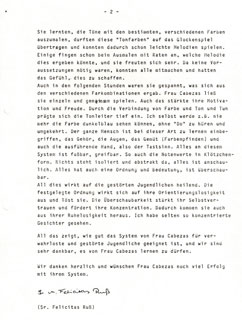Biografía
Estela Cabezas
A los 5 años inicia los estudios de piano y a los 7 se destaca con el primer lugar en el concurso de piano organizado por el Grupo Chopin de Temuco.
Sus estudios los inicia en el Conservatorio de Música de Temuco.
En 1944 se casa y traslada a Santiago donde continúa con los estudios de piano superior con los maestros Rosita Renard y René Amengual, además de estudios de composición, armonía y contrapunto con Pedro Humberto Allende y posteriormente entre 1960-61 con Federico Heinlein, Juan Orrego Salas y Juan Pablo Izquierdo en el Departamento de Música de la Pontificia Universidad Católica.
Escribió obras para piano solo, violoncello y piano, canto y piano; coro.
El estilo desarrollado por la compositora se considera neorromántico con cierta tendencia al impresionismo y moderado uso en algunas obras de elementos folclóricos estilizados (aires de tonada y zamba). Todo dentro de un ámbito armónico tradicional.
Raquel Bustos, musicóloga y autora del libro “La mujer compositora y su aporte al desarrollo musical chileno” publicado en 2013, destaca a nueve mujeres por su dedicación a la disciplina entre ellas a Estela Cabezas Espinoza.

Disco "Estela Cabezas, Obras Selectas" en Spotify
Selección de composiciones de Estela Cabezas interpretadas por Leonora Letelier y exalumnos del método.
Película "ESTELA, Concierto-Homenaje"
Documental musical que rescata el legado patrimonial de Estela Cabezas en el centenario de su natalicio.
Donación al Archivo de Música de la Biblioteca Nacional
Donación del Archivo histórico de Estela Cabezas y Joan Zambrano.
Interpretaciones de obras de Estela Cabezas
La vocación pedagógica despierta en Estela Cabezas con la maternidad, deseando formar musicalmente a sus tres primeros hijos. Más tarde, en la década de los 60, dando clases de piano con el sistema tradicional, observa lo árido y excluyente que resulta para la mayoría de los niños el estudio de la música y de un instrumento.
Estela Cabezas investiga y busca otras alternativas y no encontrando una que la convenciera, comienza a experimentar buscando formas para llegar a niños que no tenían especiales condiciones para la disciplina del aprendizaje de la música.
A partir de su natural disposición acogedora, afectuosa y generosa sin discriminar a ningún niño por sus mayores o menores habilidades, considerando los distintos procesos de aprendizaje inicia la creación de lo que más tarde llama método Música en Colores, un método que considera el mundo perceptivo infantil e intereses con recursos lúdicos, sensoriales, estéticos, visuales y auditivos donde los niños juegan y aprenden, estimulando su creatividad y desarrollando sus capacidades musicales.
En archivos familiares, Estela Cabezas expresa: “Dediqué a este proyecto más de 10 años de investigación y experimentación, hasta plasmar mi búsqueda en la obra didáctica denominada Música en Colores, publicada después de otros 10 años por Ediciones Universitarias de Valparaíso en 1980”.
hitos de estela cabezas
línea temporal
1969

Viaja a Nueva York y expone en la Universidad de Michigan.
1971

En los 70 en diarios y revistas se publica la obra pedagógica de Estela Cabezas, como la siguiente imagen de la revista EVA, Nº 1355 del 14 de mayo de 1971.
1972

En el ámbito nacional, el 24 de noviembre de 1972, el Ministerio de Educación declara material didáctico complementario el libro de texto, su guía y el material didáctico Música en Colores para la iniciación de la enseñanza del piano.
1981

Años después, en Brasil, el “Jornal de Sao Paulo” publica: El método desarrollado por la compositora chilena Estela Cabezas, tiene un carácter eminentemente lúdico, consistiendo en una serie de juegos y entretenimiento con canciones y material didáctico propios. Cada nota musical está representada por un color y sus valores por figuras cuadradas y rectangulares que proporcionan una correcta y simplificada grafía del sonido, haciendo que los niños aprendan con los ojos, con los oídos y con el tacto, pues los elementos abstractos de la música se entregan en forma objetiva y palpable.
1983

En España la destacada profesora María Cateura, catedrática del Conservatorio Municipal de Barcelona, dice: “…el método lo considero de gran interés para la iniciación de la música, aparte de que es muy original y presenta los contenidos con una perfecta graduación de las dificultades. Lo he presentado y comentado a mis alumnos de pedagogía del conservatorio…”.
En Alemania da clases en un hogar de niñas adolescentes. Aún con la dificultad del idioma, las chicas responden a sus clases, comprenden y aprenden música en forma fácil rápida y amena. Felicitas Russ, directora de Haus vom Guten Hirten, en Colonia, expresa: “Este sistema de aprender compromete a la persona entera, el oído, la vista, lo afectivo, la sensibilidad con respecto al color y el tacto. Todo el sistema es muy claro. El conjunto de todos estos fenómenos actúa sobre estas jóvenes como una verdadera curación. El orden que el método exige, repercute sobre su falta de orientación fomentando su capacidad de concentración…”.
1984

También en Alemania el profesor doctor Ludolf Lützen, Colonia, Alemania, 24 de enero de 1984, informa: “…el trabajo realizado por la señora Cabezas nos convence, especialmente por su estructura lógica…
1984

…el empleo de materiales pedagógicos y a la inclusión de símbolos representativos de diversos parámetros como por ejemplo la duración de los tonos, su altura y otros”.




